Motivation at Work: Analyzing Personality and Individual Differences
VerifiedAdded on 2023/06/15
|14
|3622
|462
Report
AI Summary
This report explores the intricate relationship between personality and individual differences in the context of workplace motivation. It delves into various personality theories, including the Enneagram, OCEAN model, and MBTI, to understand how these factors influence an employee's motivation. The report further examines the importance and effectiveness of motivation, highlighting McClelland's Theory of Motivation and its application to Enneagram personalities. It discusses potential results and shortcomings of motivational strategies, offering solutions to limitations. The analysis emphasizes the significance of aligning motivational approaches with individual personality traits to enhance job satisfaction, productivity, and overall organizational behavior. Desklib provides access to similar solved assignments and resources for students.
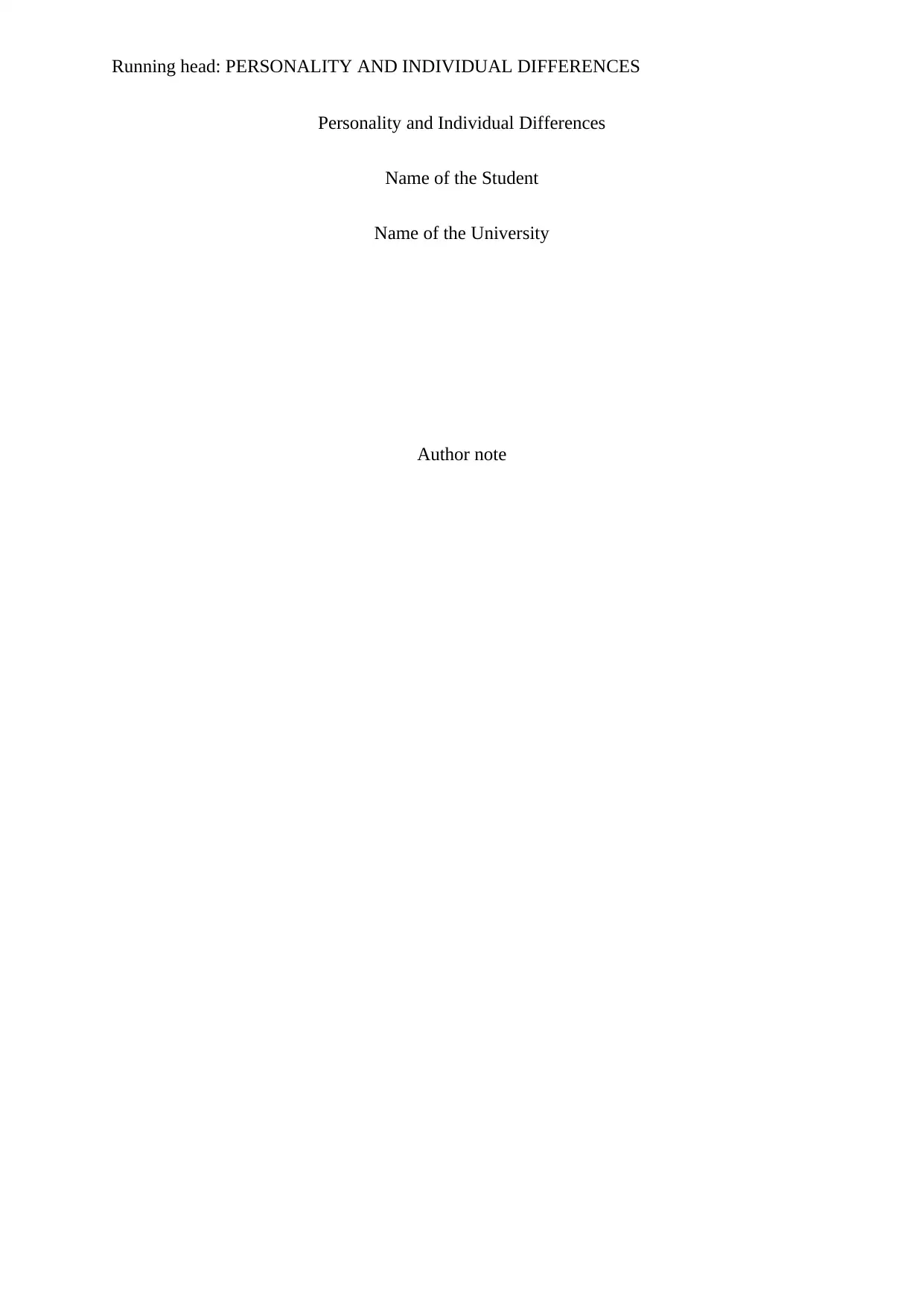
Running head: PERSONALITY AND INDIVIDUAL DIFFERENCES
Personality and Individual Differences
Name of the Student
Name of the University
Author note
Personality and Individual Differences
Name of the Student
Name of the University
Author note
Paraphrase This Document
Need a fresh take? Get an instant paraphrase of this document with our AI Paraphraser
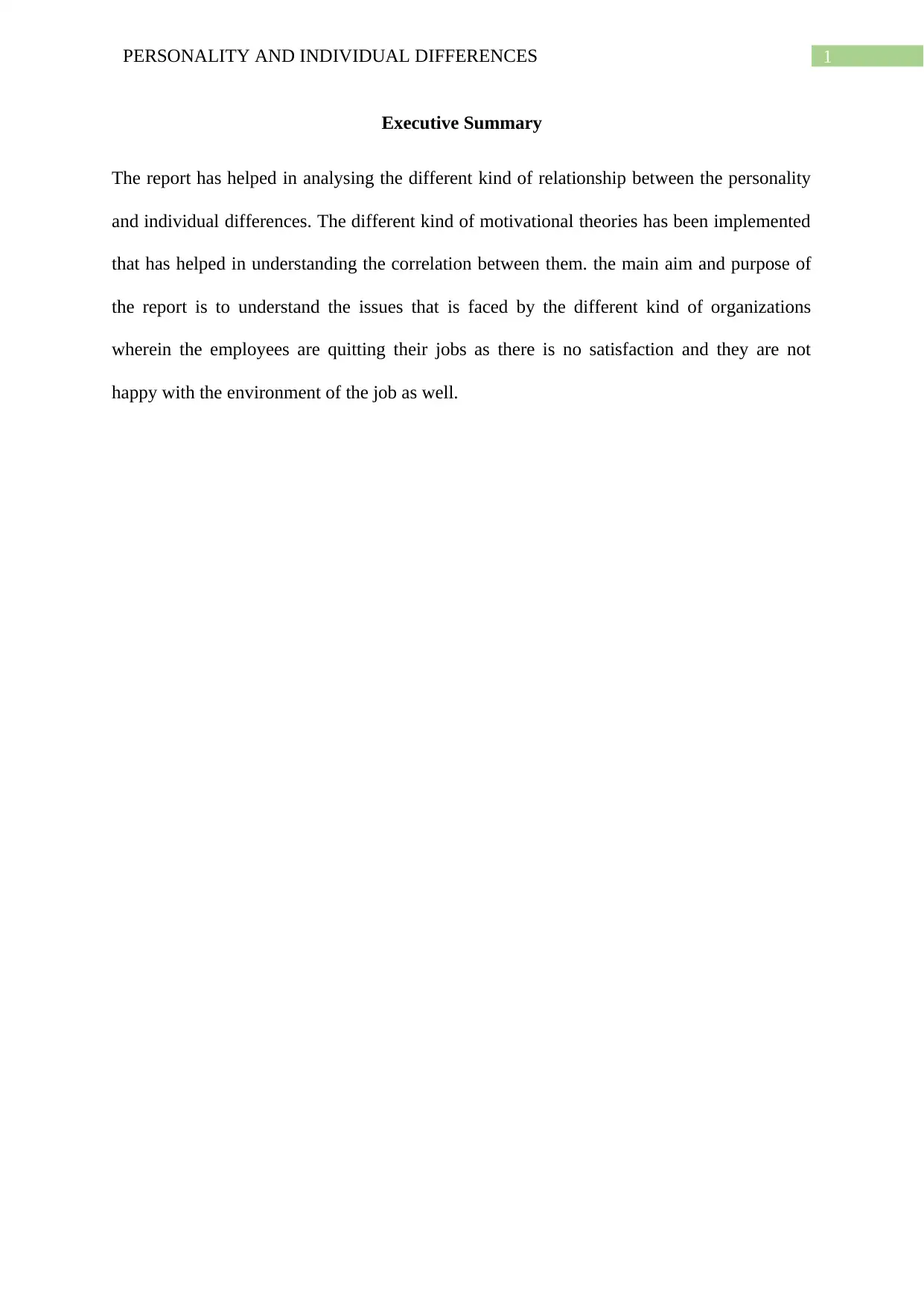
1PERSONALITY AND INDIVIDUAL DIFFERENCES
Executive Summary
The report has helped in analysing the different kind of relationship between the personality
and individual differences. The different kind of motivational theories has been implemented
that has helped in understanding the correlation between them. the main aim and purpose of
the report is to understand the issues that is faced by the different kind of organizations
wherein the employees are quitting their jobs as there is no satisfaction and they are not
happy with the environment of the job as well.
Executive Summary
The report has helped in analysing the different kind of relationship between the personality
and individual differences. The different kind of motivational theories has been implemented
that has helped in understanding the correlation between them. the main aim and purpose of
the report is to understand the issues that is faced by the different kind of organizations
wherein the employees are quitting their jobs as there is no satisfaction and they are not
happy with the environment of the job as well.
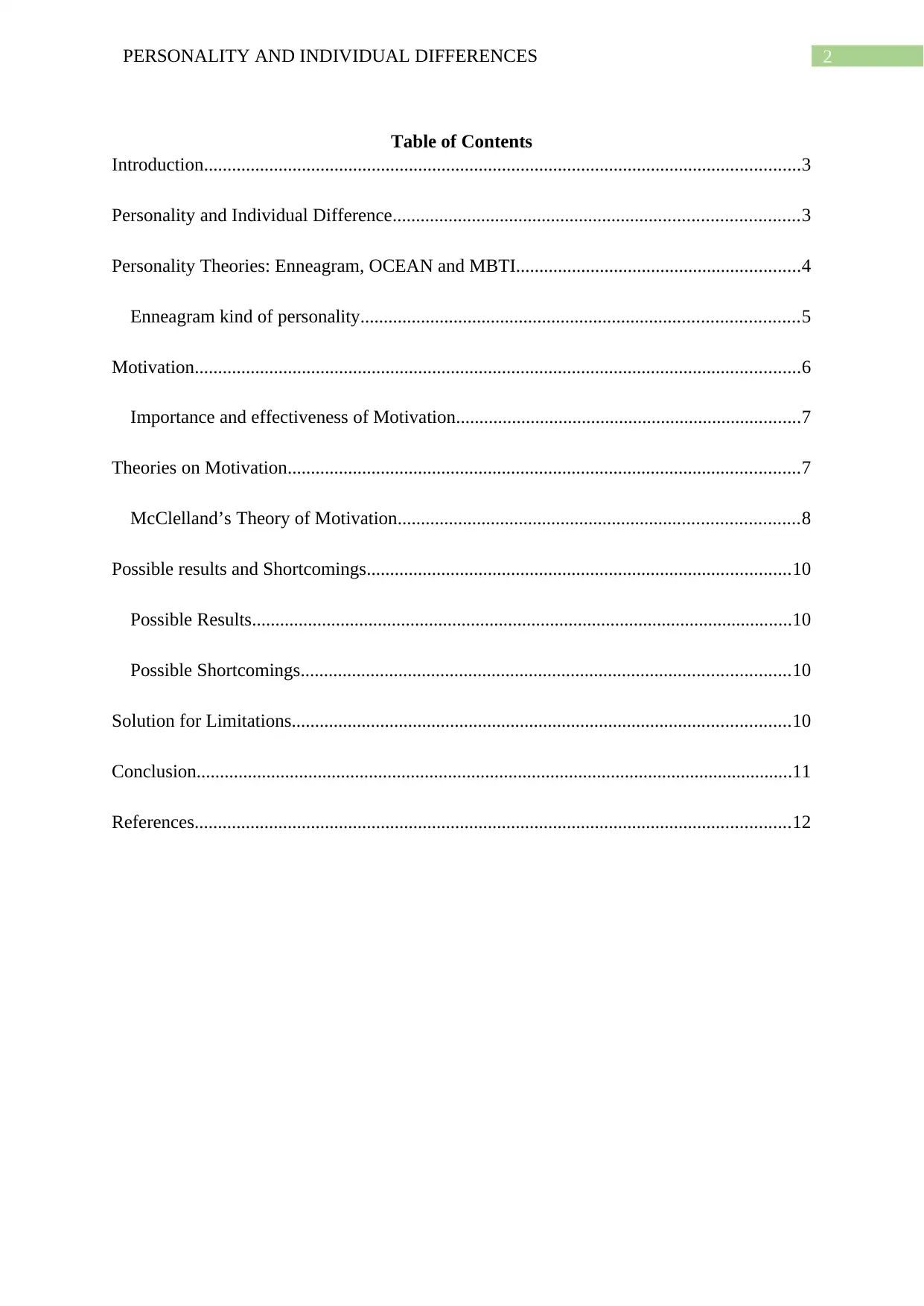
2PERSONALITY AND INDIVIDUAL DIFFERENCES
Table of Contents
Introduction................................................................................................................................3
Personality and Individual Difference.......................................................................................3
Personality Theories: Enneagram, OCEAN and MBTI.............................................................4
Enneagram kind of personality..............................................................................................5
Motivation..................................................................................................................................6
Importance and effectiveness of Motivation..........................................................................7
Theories on Motivation..............................................................................................................7
McClelland’s Theory of Motivation......................................................................................8
Possible results and Shortcomings...........................................................................................10
Possible Results....................................................................................................................10
Possible Shortcomings.........................................................................................................10
Solution for Limitations...........................................................................................................10
Conclusion................................................................................................................................11
References................................................................................................................................12
Table of Contents
Introduction................................................................................................................................3
Personality and Individual Difference.......................................................................................3
Personality Theories: Enneagram, OCEAN and MBTI.............................................................4
Enneagram kind of personality..............................................................................................5
Motivation..................................................................................................................................6
Importance and effectiveness of Motivation..........................................................................7
Theories on Motivation..............................................................................................................7
McClelland’s Theory of Motivation......................................................................................8
Possible results and Shortcomings...........................................................................................10
Possible Results....................................................................................................................10
Possible Shortcomings.........................................................................................................10
Solution for Limitations...........................................................................................................10
Conclusion................................................................................................................................11
References................................................................................................................................12
⊘ This is a preview!⊘
Do you want full access?
Subscribe today to unlock all pages.

Trusted by 1+ million students worldwide
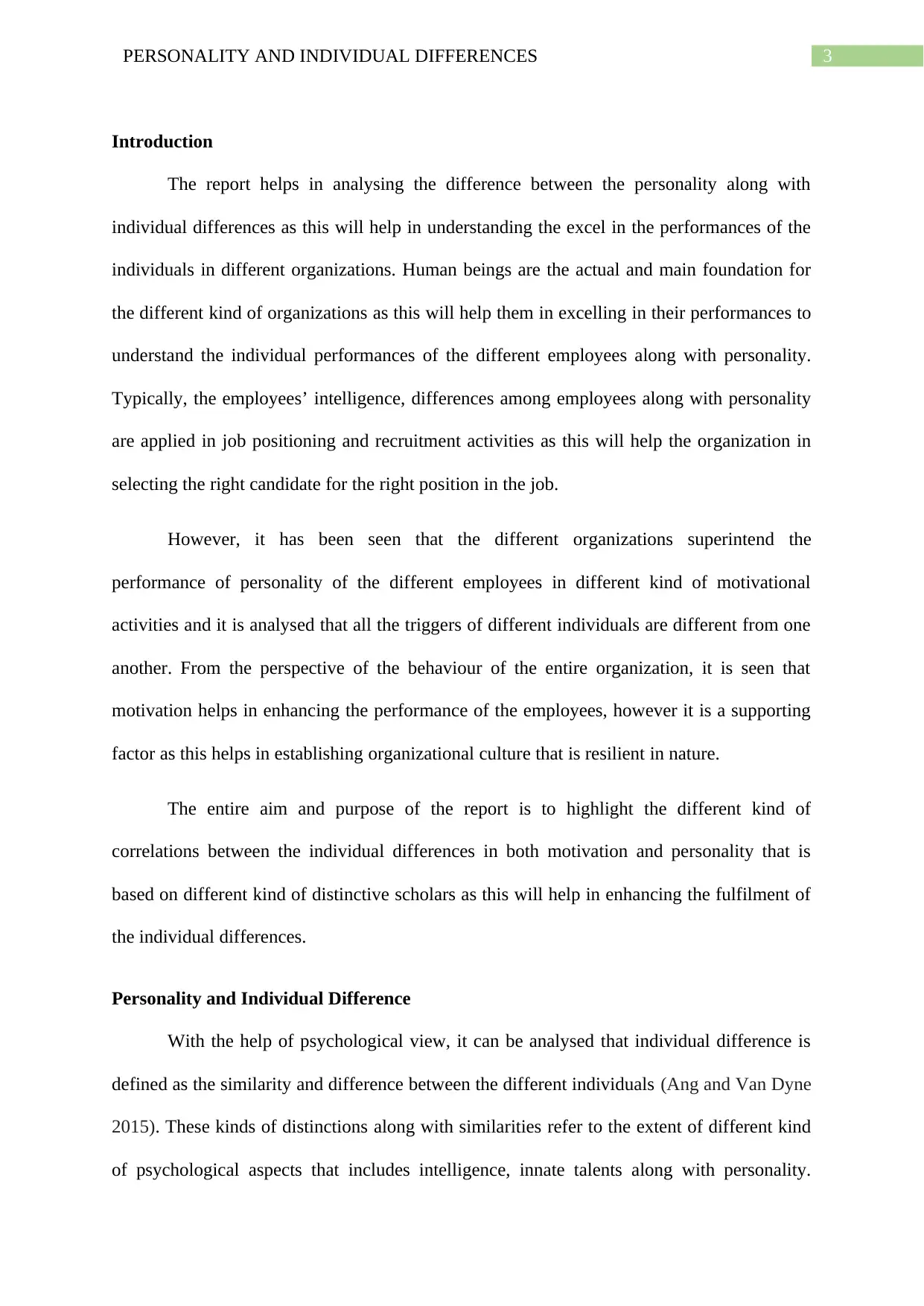
3PERSONALITY AND INDIVIDUAL DIFFERENCES
Introduction
The report helps in analysing the difference between the personality along with
individual differences as this will help in understanding the excel in the performances of the
individuals in different organizations. Human beings are the actual and main foundation for
the different kind of organizations as this will help them in excelling in their performances to
understand the individual performances of the different employees along with personality.
Typically, the employees’ intelligence, differences among employees along with personality
are applied in job positioning and recruitment activities as this will help the organization in
selecting the right candidate for the right position in the job.
However, it has been seen that the different organizations superintend the
performance of personality of the different employees in different kind of motivational
activities and it is analysed that all the triggers of different individuals are different from one
another. From the perspective of the behaviour of the entire organization, it is seen that
motivation helps in enhancing the performance of the employees, however it is a supporting
factor as this helps in establishing organizational culture that is resilient in nature.
The entire aim and purpose of the report is to highlight the different kind of
correlations between the individual differences in both motivation and personality that is
based on different kind of distinctive scholars as this will help in enhancing the fulfilment of
the individual differences.
Personality and Individual Difference
With the help of psychological view, it can be analysed that individual difference is
defined as the similarity and difference between the different individuals (Ang and Van Dyne
2015). These kinds of distinctions along with similarities refer to the extent of different kind
of psychological aspects that includes intelligence, innate talents along with personality.
Introduction
The report helps in analysing the difference between the personality along with
individual differences as this will help in understanding the excel in the performances of the
individuals in different organizations. Human beings are the actual and main foundation for
the different kind of organizations as this will help them in excelling in their performances to
understand the individual performances of the different employees along with personality.
Typically, the employees’ intelligence, differences among employees along with personality
are applied in job positioning and recruitment activities as this will help the organization in
selecting the right candidate for the right position in the job.
However, it has been seen that the different organizations superintend the
performance of personality of the different employees in different kind of motivational
activities and it is analysed that all the triggers of different individuals are different from one
another. From the perspective of the behaviour of the entire organization, it is seen that
motivation helps in enhancing the performance of the employees, however it is a supporting
factor as this helps in establishing organizational culture that is resilient in nature.
The entire aim and purpose of the report is to highlight the different kind of
correlations between the individual differences in both motivation and personality that is
based on different kind of distinctive scholars as this will help in enhancing the fulfilment of
the individual differences.
Personality and Individual Difference
With the help of psychological view, it can be analysed that individual difference is
defined as the similarity and difference between the different individuals (Ang and Van Dyne
2015). These kinds of distinctions along with similarities refer to the extent of different kind
of psychological aspects that includes intelligence, innate talents along with personality.
Paraphrase This Document
Need a fresh take? Get an instant paraphrase of this document with our AI Paraphraser
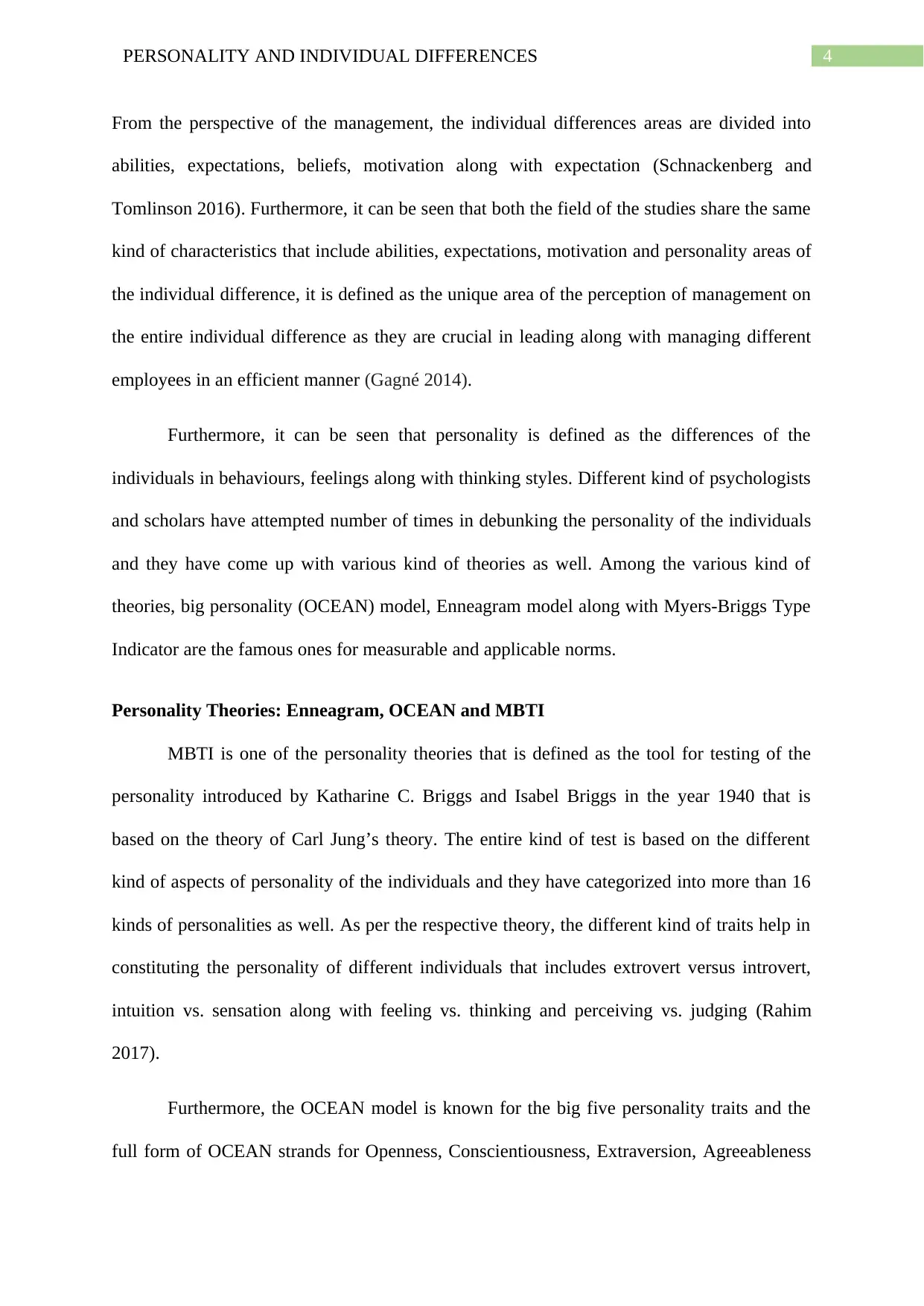
4PERSONALITY AND INDIVIDUAL DIFFERENCES
From the perspective of the management, the individual differences areas are divided into
abilities, expectations, beliefs, motivation along with expectation (Schnackenberg and
Tomlinson 2016). Furthermore, it can be seen that both the field of the studies share the same
kind of characteristics that include abilities, expectations, motivation and personality areas of
the individual difference, it is defined as the unique area of the perception of management on
the entire individual difference as they are crucial in leading along with managing different
employees in an efficient manner (Gagné 2014).
Furthermore, it can be seen that personality is defined as the differences of the
individuals in behaviours, feelings along with thinking styles. Different kind of psychologists
and scholars have attempted number of times in debunking the personality of the individuals
and they have come up with various kind of theories as well. Among the various kind of
theories, big personality (OCEAN) model, Enneagram model along with Myers-Briggs Type
Indicator are the famous ones for measurable and applicable norms.
Personality Theories: Enneagram, OCEAN and MBTI
MBTI is one of the personality theories that is defined as the tool for testing of the
personality introduced by Katharine C. Briggs and Isabel Briggs in the year 1940 that is
based on the theory of Carl Jung’s theory. The entire kind of test is based on the different
kind of aspects of personality of the individuals and they have categorized into more than 16
kinds of personalities as well. As per the respective theory, the different kind of traits help in
constituting the personality of different individuals that includes extrovert versus introvert,
intuition vs. sensation along with feeling vs. thinking and perceiving vs. judging (Rahim
2017).
Furthermore, the OCEAN model is known for the big five personality traits and the
full form of OCEAN strands for Openness, Conscientiousness, Extraversion, Agreeableness
From the perspective of the management, the individual differences areas are divided into
abilities, expectations, beliefs, motivation along with expectation (Schnackenberg and
Tomlinson 2016). Furthermore, it can be seen that both the field of the studies share the same
kind of characteristics that include abilities, expectations, motivation and personality areas of
the individual difference, it is defined as the unique area of the perception of management on
the entire individual difference as they are crucial in leading along with managing different
employees in an efficient manner (Gagné 2014).
Furthermore, it can be seen that personality is defined as the differences of the
individuals in behaviours, feelings along with thinking styles. Different kind of psychologists
and scholars have attempted number of times in debunking the personality of the individuals
and they have come up with various kind of theories as well. Among the various kind of
theories, big personality (OCEAN) model, Enneagram model along with Myers-Briggs Type
Indicator are the famous ones for measurable and applicable norms.
Personality Theories: Enneagram, OCEAN and MBTI
MBTI is one of the personality theories that is defined as the tool for testing of the
personality introduced by Katharine C. Briggs and Isabel Briggs in the year 1940 that is
based on the theory of Carl Jung’s theory. The entire kind of test is based on the different
kind of aspects of personality of the individuals and they have categorized into more than 16
kinds of personalities as well. As per the respective theory, the different kind of traits help in
constituting the personality of different individuals that includes extrovert versus introvert,
intuition vs. sensation along with feeling vs. thinking and perceiving vs. judging (Rahim
2017).
Furthermore, the OCEAN model is known for the big five personality traits and the
full form of OCEAN strands for Openness, Conscientiousness, Extraversion, Agreeableness
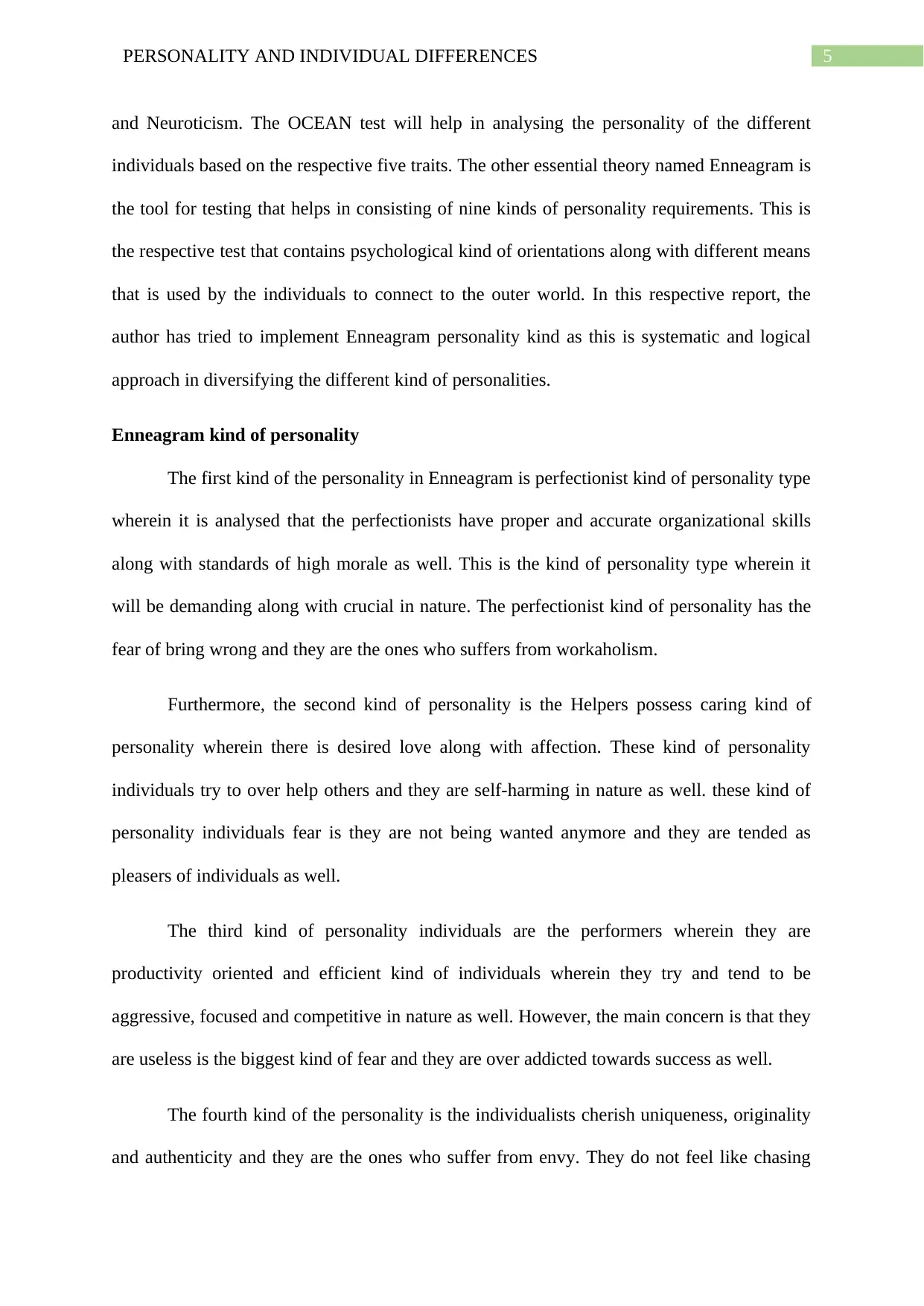
5PERSONALITY AND INDIVIDUAL DIFFERENCES
and Neuroticism. The OCEAN test will help in analysing the personality of the different
individuals based on the respective five traits. The other essential theory named Enneagram is
the tool for testing that helps in consisting of nine kinds of personality requirements. This is
the respective test that contains psychological kind of orientations along with different means
that is used by the individuals to connect to the outer world. In this respective report, the
author has tried to implement Enneagram personality kind as this is systematic and logical
approach in diversifying the different kind of personalities.
Enneagram kind of personality
The first kind of the personality in Enneagram is perfectionist kind of personality type
wherein it is analysed that the perfectionists have proper and accurate organizational skills
along with standards of high morale as well. This is the kind of personality type wherein it
will be demanding along with crucial in nature. The perfectionist kind of personality has the
fear of bring wrong and they are the ones who suffers from workaholism.
Furthermore, the second kind of personality is the Helpers possess caring kind of
personality wherein there is desired love along with affection. These kind of personality
individuals try to over help others and they are self-harming in nature as well. these kind of
personality individuals fear is they are not being wanted anymore and they are tended as
pleasers of individuals as well.
The third kind of personality individuals are the performers wherein they are
productivity oriented and efficient kind of individuals wherein they try and tend to be
aggressive, focused and competitive in nature as well. However, the main concern is that they
are useless is the biggest kind of fear and they are over addicted towards success as well.
The fourth kind of the personality is the individualists cherish uniqueness, originality
and authenticity and they are the ones who suffer from envy. They do not feel like chasing
and Neuroticism. The OCEAN test will help in analysing the personality of the different
individuals based on the respective five traits. The other essential theory named Enneagram is
the tool for testing that helps in consisting of nine kinds of personality requirements. This is
the respective test that contains psychological kind of orientations along with different means
that is used by the individuals to connect to the outer world. In this respective report, the
author has tried to implement Enneagram personality kind as this is systematic and logical
approach in diversifying the different kind of personalities.
Enneagram kind of personality
The first kind of the personality in Enneagram is perfectionist kind of personality type
wherein it is analysed that the perfectionists have proper and accurate organizational skills
along with standards of high morale as well. This is the kind of personality type wherein it
will be demanding along with crucial in nature. The perfectionist kind of personality has the
fear of bring wrong and they are the ones who suffers from workaholism.
Furthermore, the second kind of personality is the Helpers possess caring kind of
personality wherein there is desired love along with affection. These kind of personality
individuals try to over help others and they are self-harming in nature as well. these kind of
personality individuals fear is they are not being wanted anymore and they are tended as
pleasers of individuals as well.
The third kind of personality individuals are the performers wherein they are
productivity oriented and efficient kind of individuals wherein they try and tend to be
aggressive, focused and competitive in nature as well. However, the main concern is that they
are useless is the biggest kind of fear and they are over addicted towards success as well.
The fourth kind of the personality is the individualists cherish uniqueness, originality
and authenticity and they are the ones who suffer from envy. They do not feel like chasing
⊘ This is a preview!⊘
Do you want full access?
Subscribe today to unlock all pages.

Trusted by 1+ million students worldwide
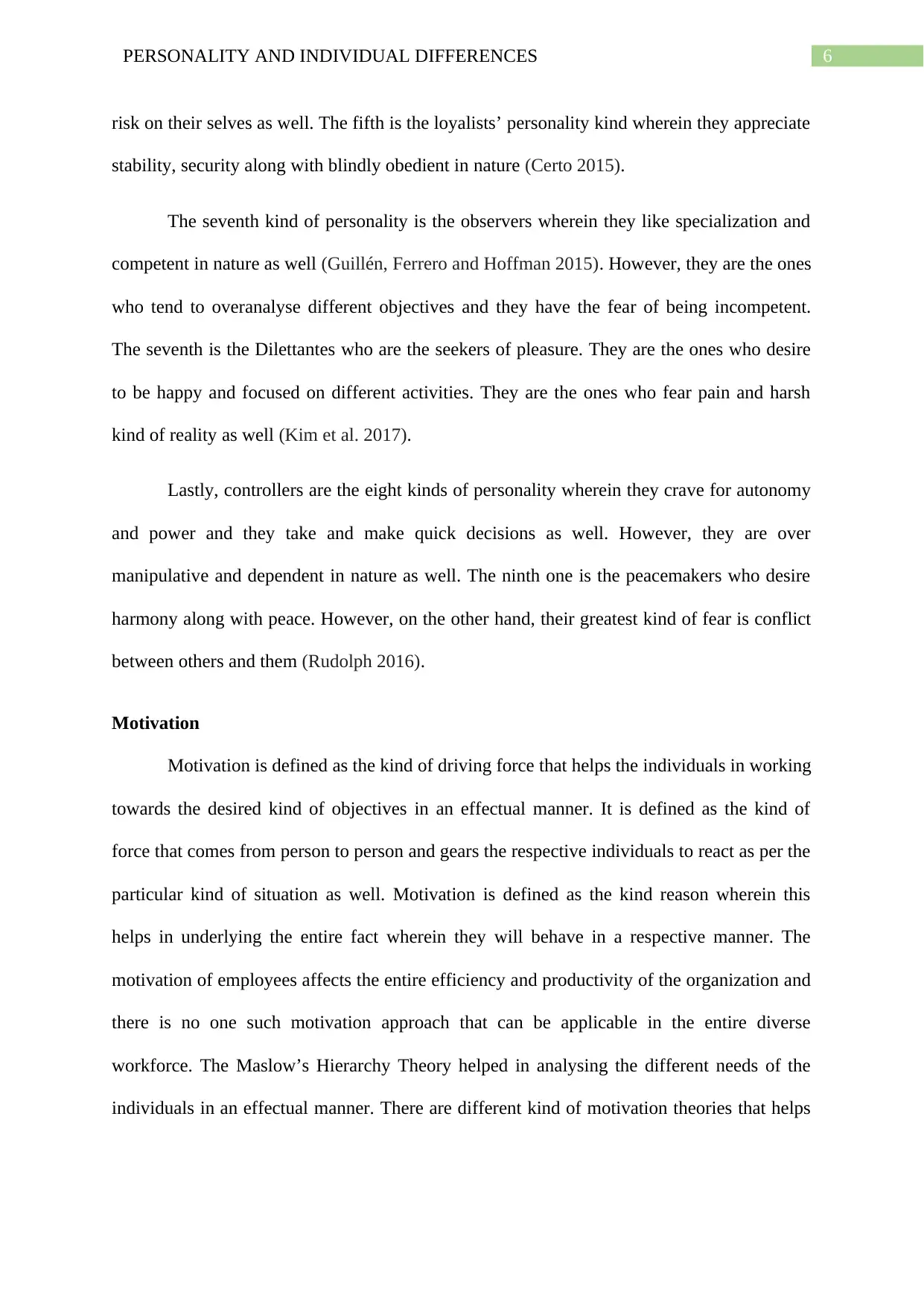
6PERSONALITY AND INDIVIDUAL DIFFERENCES
risk on their selves as well. The fifth is the loyalists’ personality kind wherein they appreciate
stability, security along with blindly obedient in nature (Certo 2015).
The seventh kind of personality is the observers wherein they like specialization and
competent in nature as well (Guillén, Ferrero and Hoffman 2015). However, they are the ones
who tend to overanalyse different objectives and they have the fear of being incompetent.
The seventh is the Dilettantes who are the seekers of pleasure. They are the ones who desire
to be happy and focused on different activities. They are the ones who fear pain and harsh
kind of reality as well (Kim et al. 2017).
Lastly, controllers are the eight kinds of personality wherein they crave for autonomy
and power and they take and make quick decisions as well. However, they are over
manipulative and dependent in nature as well. The ninth one is the peacemakers who desire
harmony along with peace. However, on the other hand, their greatest kind of fear is conflict
between others and them (Rudolph 2016).
Motivation
Motivation is defined as the kind of driving force that helps the individuals in working
towards the desired kind of objectives in an effectual manner. It is defined as the kind of
force that comes from person to person and gears the respective individuals to react as per the
particular kind of situation as well. Motivation is defined as the kind reason wherein this
helps in underlying the entire fact wherein they will behave in a respective manner. The
motivation of employees affects the entire efficiency and productivity of the organization and
there is no one such motivation approach that can be applicable in the entire diverse
workforce. The Maslow’s Hierarchy Theory helped in analysing the different needs of the
individuals in an effectual manner. There are different kind of motivation theories that helps
risk on their selves as well. The fifth is the loyalists’ personality kind wherein they appreciate
stability, security along with blindly obedient in nature (Certo 2015).
The seventh kind of personality is the observers wherein they like specialization and
competent in nature as well (Guillén, Ferrero and Hoffman 2015). However, they are the ones
who tend to overanalyse different objectives and they have the fear of being incompetent.
The seventh is the Dilettantes who are the seekers of pleasure. They are the ones who desire
to be happy and focused on different activities. They are the ones who fear pain and harsh
kind of reality as well (Kim et al. 2017).
Lastly, controllers are the eight kinds of personality wherein they crave for autonomy
and power and they take and make quick decisions as well. However, they are over
manipulative and dependent in nature as well. The ninth one is the peacemakers who desire
harmony along with peace. However, on the other hand, their greatest kind of fear is conflict
between others and them (Rudolph 2016).
Motivation
Motivation is defined as the kind of driving force that helps the individuals in working
towards the desired kind of objectives in an effectual manner. It is defined as the kind of
force that comes from person to person and gears the respective individuals to react as per the
particular kind of situation as well. Motivation is defined as the kind reason wherein this
helps in underlying the entire fact wherein they will behave in a respective manner. The
motivation of employees affects the entire efficiency and productivity of the organization and
there is no one such motivation approach that can be applicable in the entire diverse
workforce. The Maslow’s Hierarchy Theory helped in analysing the different needs of the
individuals in an effectual manner. There are different kind of motivation theories that helps
Paraphrase This Document
Need a fresh take? Get an instant paraphrase of this document with our AI Paraphraser
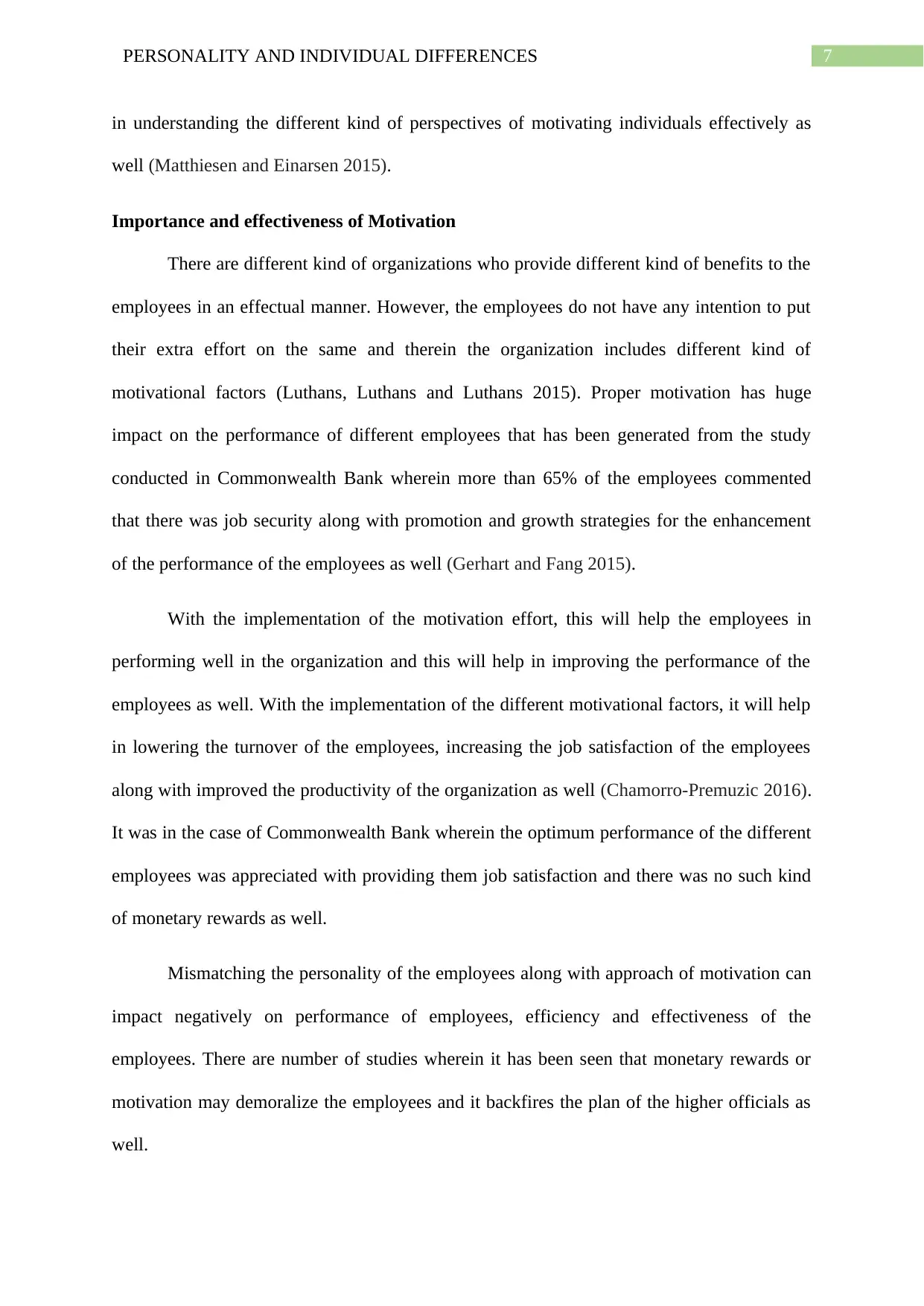
7PERSONALITY AND INDIVIDUAL DIFFERENCES
in understanding the different kind of perspectives of motivating individuals effectively as
well (Matthiesen and Einarsen 2015).
Importance and effectiveness of Motivation
There are different kind of organizations who provide different kind of benefits to the
employees in an effectual manner. However, the employees do not have any intention to put
their extra effort on the same and therein the organization includes different kind of
motivational factors (Luthans, Luthans and Luthans 2015). Proper motivation has huge
impact on the performance of different employees that has been generated from the study
conducted in Commonwealth Bank wherein more than 65% of the employees commented
that there was job security along with promotion and growth strategies for the enhancement
of the performance of the employees as well (Gerhart and Fang 2015).
With the implementation of the motivation effort, this will help the employees in
performing well in the organization and this will help in improving the performance of the
employees as well. With the implementation of the different motivational factors, it will help
in lowering the turnover of the employees, increasing the job satisfaction of the employees
along with improved the productivity of the organization as well (Chamorro-Premuzic 2016).
It was in the case of Commonwealth Bank wherein the optimum performance of the different
employees was appreciated with providing them job satisfaction and there was no such kind
of monetary rewards as well.
Mismatching the personality of the employees along with approach of motivation can
impact negatively on performance of employees, efficiency and effectiveness of the
employees. There are number of studies wherein it has been seen that monetary rewards or
motivation may demoralize the employees and it backfires the plan of the higher officials as
well.
in understanding the different kind of perspectives of motivating individuals effectively as
well (Matthiesen and Einarsen 2015).
Importance and effectiveness of Motivation
There are different kind of organizations who provide different kind of benefits to the
employees in an effectual manner. However, the employees do not have any intention to put
their extra effort on the same and therein the organization includes different kind of
motivational factors (Luthans, Luthans and Luthans 2015). Proper motivation has huge
impact on the performance of different employees that has been generated from the study
conducted in Commonwealth Bank wherein more than 65% of the employees commented
that there was job security along with promotion and growth strategies for the enhancement
of the performance of the employees as well (Gerhart and Fang 2015).
With the implementation of the motivation effort, this will help the employees in
performing well in the organization and this will help in improving the performance of the
employees as well. With the implementation of the different motivational factors, it will help
in lowering the turnover of the employees, increasing the job satisfaction of the employees
along with improved the productivity of the organization as well (Chamorro-Premuzic 2016).
It was in the case of Commonwealth Bank wherein the optimum performance of the different
employees was appreciated with providing them job satisfaction and there was no such kind
of monetary rewards as well.
Mismatching the personality of the employees along with approach of motivation can
impact negatively on performance of employees, efficiency and effectiveness of the
employees. There are number of studies wherein it has been seen that monetary rewards or
motivation may demoralize the employees and it backfires the plan of the higher officials as
well.
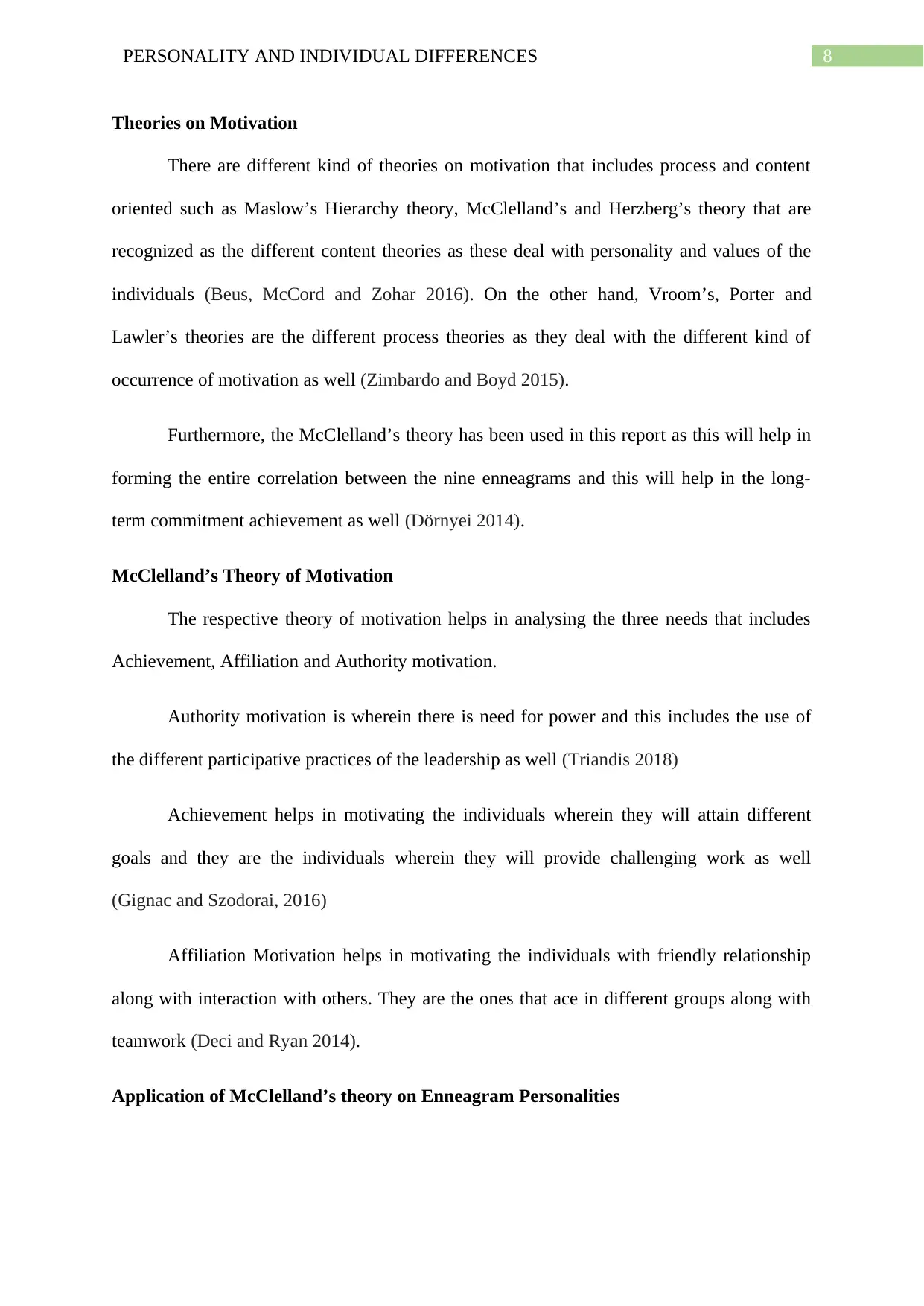
8PERSONALITY AND INDIVIDUAL DIFFERENCES
Theories on Motivation
There are different kind of theories on motivation that includes process and content
oriented such as Maslow’s Hierarchy theory, McClelland’s and Herzberg’s theory that are
recognized as the different content theories as these deal with personality and values of the
individuals (Beus, McCord and Zohar 2016). On the other hand, Vroom’s, Porter and
Lawler’s theories are the different process theories as they deal with the different kind of
occurrence of motivation as well (Zimbardo and Boyd 2015).
Furthermore, the McClelland’s theory has been used in this report as this will help in
forming the entire correlation between the nine enneagrams and this will help in the long-
term commitment achievement as well (Dörnyei 2014).
McClelland’s Theory of Motivation
The respective theory of motivation helps in analysing the three needs that includes
Achievement, Affiliation and Authority motivation.
Authority motivation is wherein there is need for power and this includes the use of
the different participative practices of the leadership as well (Triandis 2018)
Achievement helps in motivating the individuals wherein they will attain different
goals and they are the individuals wherein they will provide challenging work as well
(Gignac and Szodorai, 2016)
Affiliation Motivation helps in motivating the individuals with friendly relationship
along with interaction with others. They are the ones that ace in different groups along with
teamwork (Deci and Ryan 2014).
Application of McClelland’s theory on Enneagram Personalities
Theories on Motivation
There are different kind of theories on motivation that includes process and content
oriented such as Maslow’s Hierarchy theory, McClelland’s and Herzberg’s theory that are
recognized as the different content theories as these deal with personality and values of the
individuals (Beus, McCord and Zohar 2016). On the other hand, Vroom’s, Porter and
Lawler’s theories are the different process theories as they deal with the different kind of
occurrence of motivation as well (Zimbardo and Boyd 2015).
Furthermore, the McClelland’s theory has been used in this report as this will help in
forming the entire correlation between the nine enneagrams and this will help in the long-
term commitment achievement as well (Dörnyei 2014).
McClelland’s Theory of Motivation
The respective theory of motivation helps in analysing the three needs that includes
Achievement, Affiliation and Authority motivation.
Authority motivation is wherein there is need for power and this includes the use of
the different participative practices of the leadership as well (Triandis 2018)
Achievement helps in motivating the individuals wherein they will attain different
goals and they are the individuals wherein they will provide challenging work as well
(Gignac and Szodorai, 2016)
Affiliation Motivation helps in motivating the individuals with friendly relationship
along with interaction with others. They are the ones that ace in different groups along with
teamwork (Deci and Ryan 2014).
Application of McClelland’s theory on Enneagram Personalities
⊘ This is a preview!⊘
Do you want full access?
Subscribe today to unlock all pages.

Trusted by 1+ million students worldwide
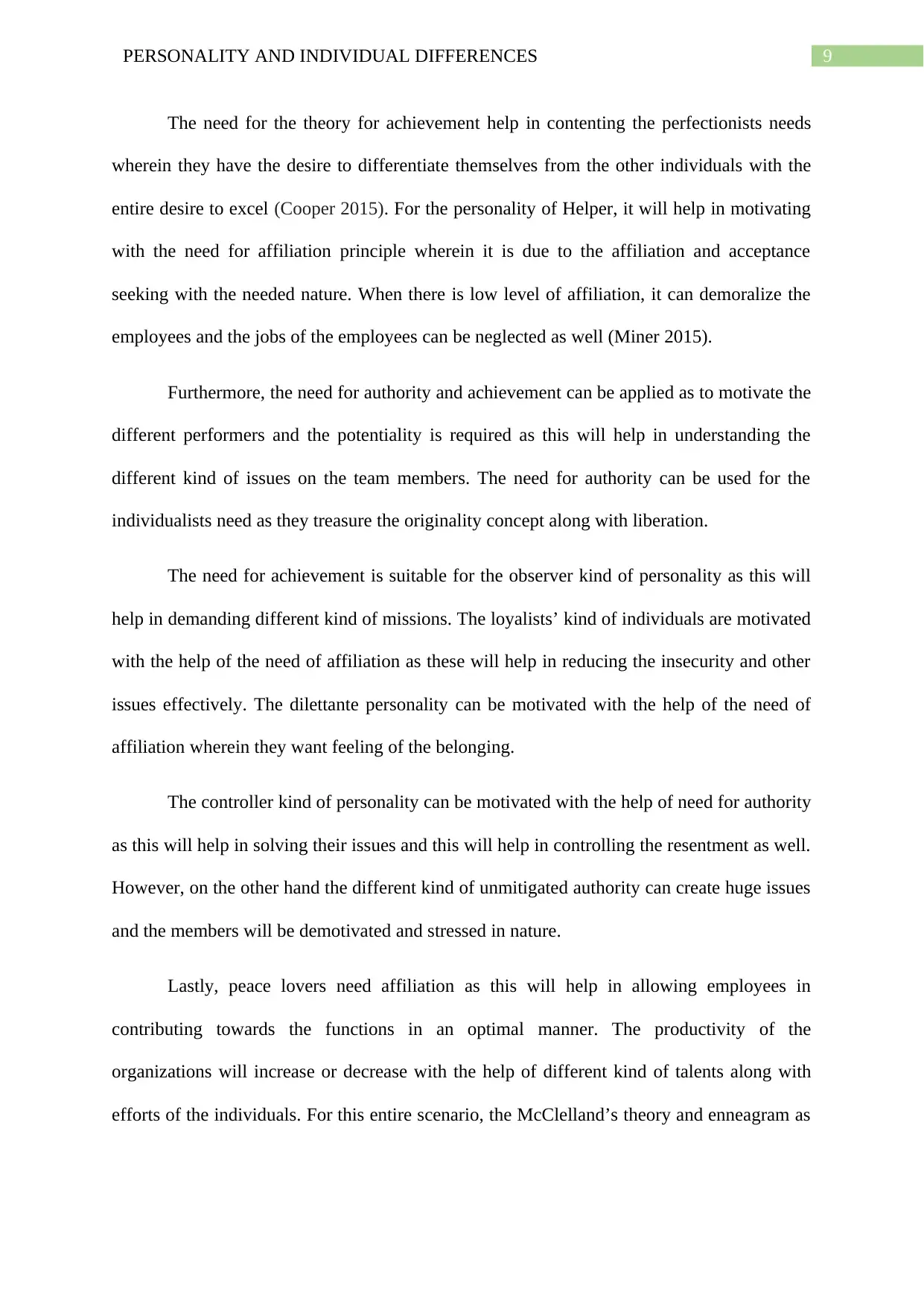
9PERSONALITY AND INDIVIDUAL DIFFERENCES
The need for the theory for achievement help in contenting the perfectionists needs
wherein they have the desire to differentiate themselves from the other individuals with the
entire desire to excel (Cooper 2015). For the personality of Helper, it will help in motivating
with the need for affiliation principle wherein it is due to the affiliation and acceptance
seeking with the needed nature. When there is low level of affiliation, it can demoralize the
employees and the jobs of the employees can be neglected as well (Miner 2015).
Furthermore, the need for authority and achievement can be applied as to motivate the
different performers and the potentiality is required as this will help in understanding the
different kind of issues on the team members. The need for authority can be used for the
individualists need as they treasure the originality concept along with liberation.
The need for achievement is suitable for the observer kind of personality as this will
help in demanding different kind of missions. The loyalists’ kind of individuals are motivated
with the help of the need of affiliation as these will help in reducing the insecurity and other
issues effectively. The dilettante personality can be motivated with the help of the need of
affiliation wherein they want feeling of the belonging.
The controller kind of personality can be motivated with the help of need for authority
as this will help in solving their issues and this will help in controlling the resentment as well.
However, on the other hand the different kind of unmitigated authority can create huge issues
and the members will be demotivated and stressed in nature.
Lastly, peace lovers need affiliation as this will help in allowing employees in
contributing towards the functions in an optimal manner. The productivity of the
organizations will increase or decrease with the help of different kind of talents along with
efforts of the individuals. For this entire scenario, the McClelland’s theory and enneagram as
The need for the theory for achievement help in contenting the perfectionists needs
wherein they have the desire to differentiate themselves from the other individuals with the
entire desire to excel (Cooper 2015). For the personality of Helper, it will help in motivating
with the need for affiliation principle wherein it is due to the affiliation and acceptance
seeking with the needed nature. When there is low level of affiliation, it can demoralize the
employees and the jobs of the employees can be neglected as well (Miner 2015).
Furthermore, the need for authority and achievement can be applied as to motivate the
different performers and the potentiality is required as this will help in understanding the
different kind of issues on the team members. The need for authority can be used for the
individualists need as they treasure the originality concept along with liberation.
The need for achievement is suitable for the observer kind of personality as this will
help in demanding different kind of missions. The loyalists’ kind of individuals are motivated
with the help of the need of affiliation as these will help in reducing the insecurity and other
issues effectively. The dilettante personality can be motivated with the help of the need of
affiliation wherein they want feeling of the belonging.
The controller kind of personality can be motivated with the help of need for authority
as this will help in solving their issues and this will help in controlling the resentment as well.
However, on the other hand the different kind of unmitigated authority can create huge issues
and the members will be demotivated and stressed in nature.
Lastly, peace lovers need affiliation as this will help in allowing employees in
contributing towards the functions in an optimal manner. The productivity of the
organizations will increase or decrease with the help of different kind of talents along with
efforts of the individuals. For this entire scenario, the McClelland’s theory and enneagram as
Paraphrase This Document
Need a fresh take? Get an instant paraphrase of this document with our AI Paraphraser
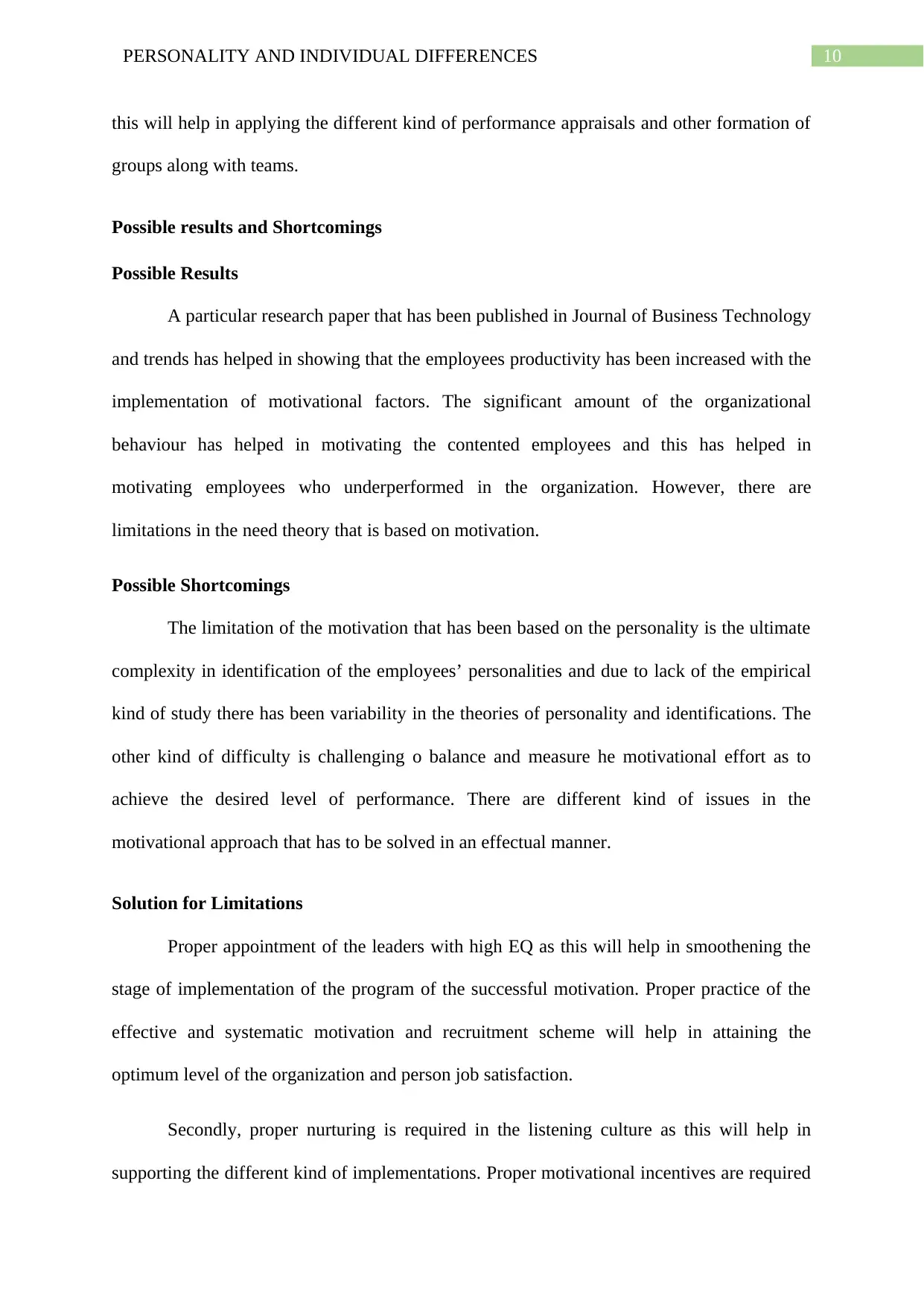
10PERSONALITY AND INDIVIDUAL DIFFERENCES
this will help in applying the different kind of performance appraisals and other formation of
groups along with teams.
Possible results and Shortcomings
Possible Results
A particular research paper that has been published in Journal of Business Technology
and trends has helped in showing that the employees productivity has been increased with the
implementation of motivational factors. The significant amount of the organizational
behaviour has helped in motivating the contented employees and this has helped in
motivating employees who underperformed in the organization. However, there are
limitations in the need theory that is based on motivation.
Possible Shortcomings
The limitation of the motivation that has been based on the personality is the ultimate
complexity in identification of the employees’ personalities and due to lack of the empirical
kind of study there has been variability in the theories of personality and identifications. The
other kind of difficulty is challenging o balance and measure he motivational effort as to
achieve the desired level of performance. There are different kind of issues in the
motivational approach that has to be solved in an effectual manner.
Solution for Limitations
Proper appointment of the leaders with high EQ as this will help in smoothening the
stage of implementation of the program of the successful motivation. Proper practice of the
effective and systematic motivation and recruitment scheme will help in attaining the
optimum level of the organization and person job satisfaction.
Secondly, proper nurturing is required in the listening culture as this will help in
supporting the different kind of implementations. Proper motivational incentives are required
this will help in applying the different kind of performance appraisals and other formation of
groups along with teams.
Possible results and Shortcomings
Possible Results
A particular research paper that has been published in Journal of Business Technology
and trends has helped in showing that the employees productivity has been increased with the
implementation of motivational factors. The significant amount of the organizational
behaviour has helped in motivating the contented employees and this has helped in
motivating employees who underperformed in the organization. However, there are
limitations in the need theory that is based on motivation.
Possible Shortcomings
The limitation of the motivation that has been based on the personality is the ultimate
complexity in identification of the employees’ personalities and due to lack of the empirical
kind of study there has been variability in the theories of personality and identifications. The
other kind of difficulty is challenging o balance and measure he motivational effort as to
achieve the desired level of performance. There are different kind of issues in the
motivational approach that has to be solved in an effectual manner.
Solution for Limitations
Proper appointment of the leaders with high EQ as this will help in smoothening the
stage of implementation of the program of the successful motivation. Proper practice of the
effective and systematic motivation and recruitment scheme will help in attaining the
optimum level of the organization and person job satisfaction.
Secondly, proper nurturing is required in the listening culture as this will help in
supporting the different kind of implementations. Proper motivational incentives are required
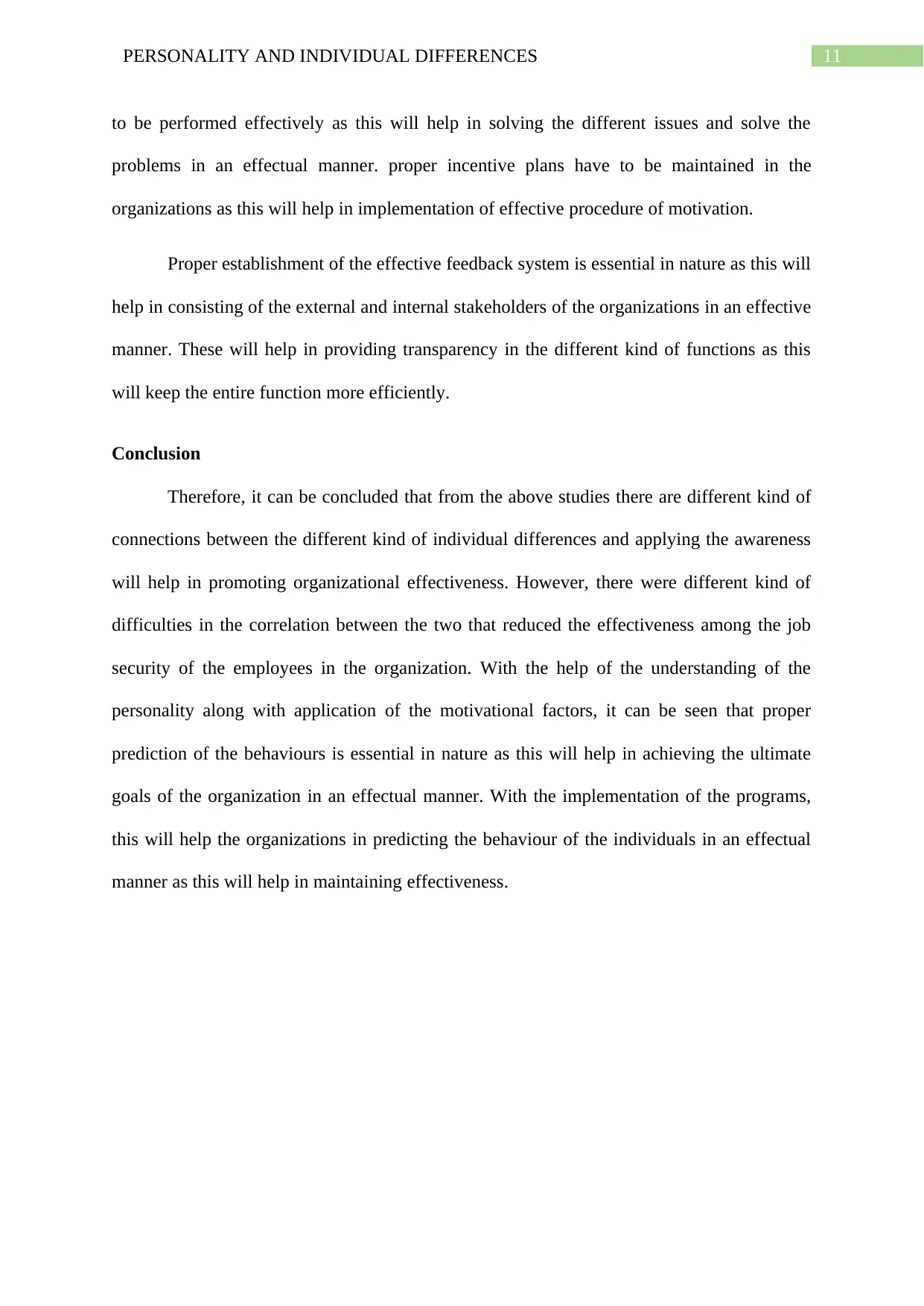
11PERSONALITY AND INDIVIDUAL DIFFERENCES
to be performed effectively as this will help in solving the different issues and solve the
problems in an effectual manner. proper incentive plans have to be maintained in the
organizations as this will help in implementation of effective procedure of motivation.
Proper establishment of the effective feedback system is essential in nature as this will
help in consisting of the external and internal stakeholders of the organizations in an effective
manner. These will help in providing transparency in the different kind of functions as this
will keep the entire function more efficiently.
Conclusion
Therefore, it can be concluded that from the above studies there are different kind of
connections between the different kind of individual differences and applying the awareness
will help in promoting organizational effectiveness. However, there were different kind of
difficulties in the correlation between the two that reduced the effectiveness among the job
security of the employees in the organization. With the help of the understanding of the
personality along with application of the motivational factors, it can be seen that proper
prediction of the behaviours is essential in nature as this will help in achieving the ultimate
goals of the organization in an effectual manner. With the implementation of the programs,
this will help the organizations in predicting the behaviour of the individuals in an effectual
manner as this will help in maintaining effectiveness.
to be performed effectively as this will help in solving the different issues and solve the
problems in an effectual manner. proper incentive plans have to be maintained in the
organizations as this will help in implementation of effective procedure of motivation.
Proper establishment of the effective feedback system is essential in nature as this will
help in consisting of the external and internal stakeholders of the organizations in an effective
manner. These will help in providing transparency in the different kind of functions as this
will keep the entire function more efficiently.
Conclusion
Therefore, it can be concluded that from the above studies there are different kind of
connections between the different kind of individual differences and applying the awareness
will help in promoting organizational effectiveness. However, there were different kind of
difficulties in the correlation between the two that reduced the effectiveness among the job
security of the employees in the organization. With the help of the understanding of the
personality along with application of the motivational factors, it can be seen that proper
prediction of the behaviours is essential in nature as this will help in achieving the ultimate
goals of the organization in an effectual manner. With the implementation of the programs,
this will help the organizations in predicting the behaviour of the individuals in an effectual
manner as this will help in maintaining effectiveness.
⊘ This is a preview!⊘
Do you want full access?
Subscribe today to unlock all pages.

Trusted by 1+ million students worldwide
1 out of 14
Related Documents
Your All-in-One AI-Powered Toolkit for Academic Success.
+13062052269
info@desklib.com
Available 24*7 on WhatsApp / Email
![[object Object]](/_next/static/media/star-bottom.7253800d.svg)
Unlock your academic potential
Copyright © 2020–2025 A2Z Services. All Rights Reserved. Developed and managed by ZUCOL.





